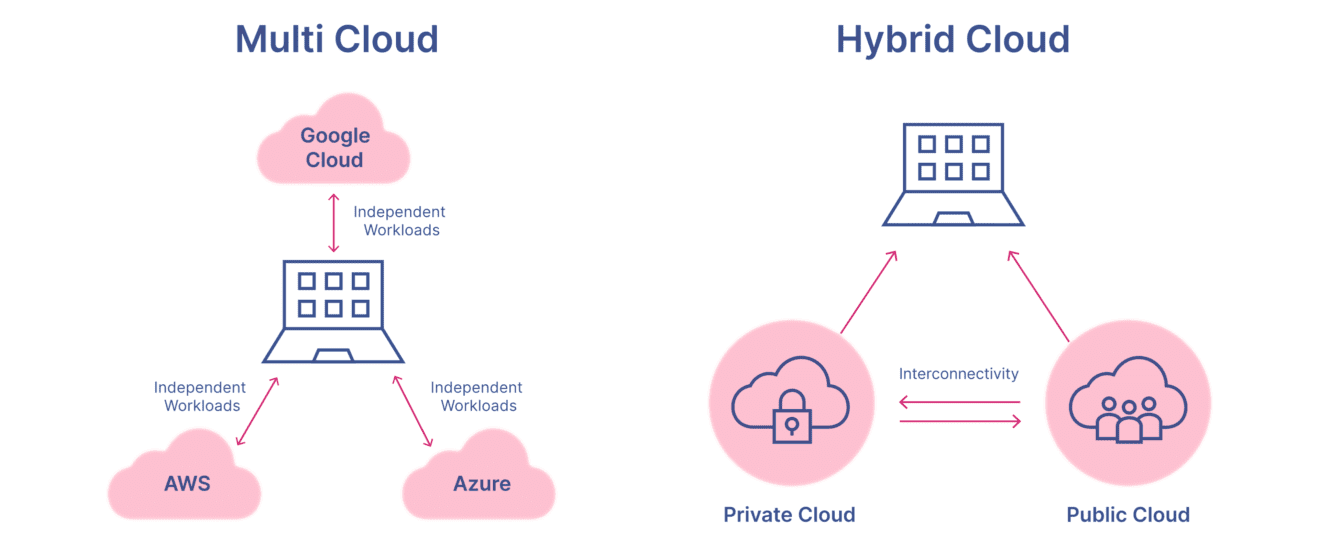9 Mins
9 Mins
Companies are now focusing on building technology and improving their IT infrastructure to reduce the cost associated with maintaining it. This has also led to an innovation boom in startups and small businesses. As the industry statistics highlight, cloud computing was valued at USD 587.78 billion in 2023. According to the forecast, the market will grow from USD 676.29 billion in 2024 to USD 2,291.59 billion by 2032, exhibiting a CAGR of 16.5%.
This shows a significant divergence of businesses towards technology. However, to get the most out of it, you must understand the right strategy to adopt with your cloud architecture. Here, selecting the strategies from the multi-cloud and hybrid cloud comes in.
A multi-cloud strategy allows businesses to select the cloud services and technologies that best fit their needs, boosting operations, cutting costs, and increasing productivity. On the other hand, hybrid cloud solutions are a viable option for businesses handling extremely confidential and sensitive data. In this blog, let us explore multi-cloud and hybrid cloud in detail.
Companies are now focusing on building technology and improving their IT infrastructure to reduce the cost associated with maintaining it. This has also led to an innovation boom in startups and small businesses. As the industry statistics highlight, cloud computing was valued at USD 587.78 billion in 2023. According to the forecast, the market will grow from USD 676.29 billion in 2024 to USD 2,291.59 billion by 2032, exhibiting a CAGR of 16.5%.
This shows a significant divergence of businesses towards technology. However, to get the most out of it, you must understand the right strategy to adopt with your cloud architecture. Here, selecting the strategies from the multi-cloud and hybrid cloud comes in.
A multi-cloud strategy allows businesses to select the cloud services and technologies that best fit their needs, boosting operations, cutting costs, and increasing productivity. On the other hand, hybrid cloud solutions are a viable option for businesses handling extremely confidential and sensitive data. In this blog, let us explore multi-cloud and hybrid cloud in detail.
 The multi-cloud strategy leverages services from multiple cloud providers, like Microsoft Azure, AWS, Google Cloud Platform, and others. Businesses occasionally use Platform-as-a-Service (PaaS) or Software-as-a-Service (SaaS) for a variety of processes, leaving infrastructure management and hosting tasks to IaaS (Infratructure-as-a-service) in public clouds.
The multi-cloud strategy leverages services from multiple cloud providers, like Microsoft Azure, AWS, Google Cloud Platform, and others. Businesses occasionally use Platform-as-a-Service (PaaS) or Software-as-a-Service (SaaS) for a variety of processes, leaving infrastructure management and hosting tasks to IaaS (Infratructure-as-a-service) in public clouds.
For instance, an IT service provider can use a multi-cloud approach by installing Google Cloud for websites, AWS for application development and testing, and Microsoft Azure for databases. The benefits will be no vendor lock-in, maximum budget utilization, and obtaining all available features from each source.
A hybrid cloud is a computing architecture that combines two or more distinct clouds, one of which can be a private cloud solution and the other a public cloud solution.
Implementing a hybrid cloud allows them to migrate sensitive data to private clouds and other applications to public clouds accessible to any employee at any location. The benefits include flexibility, security and availability for employees to gain secure access to corporate resources.
The table below describes the key differences between the multi-cloud and hybrid cloud.
Parameters | Multi-cloud | Hybrid Cloud |
Cost | Less expensive than Hybrid clouds | Expensive because of private clouds |
Security | More prone to data breaches due to the nature of the cloud, which is public. | Sensitive data can be stored with security. |
Cloud architecture | It is usually hosted off-site. | It can be hosted in an on-premises data center or in the data center of a third-party provider |
Flexibility and control | Limited control over hardware choices and security settings. | Can pick services as per requirement. |
Availability | High | High |
Compliance (Sensitive data) | Not recommended because of the public clouds | Can store sensitive information on private clouds |
Setup and run | Can be done easily | IT team with hosting experience is required |
Businesses are starting to recognize the value of multi-cloud strategies for a number of reasons. The following are some advantages of a multi-cloud strategy:
A company can use a multi-cloud strategy to manage its vast scale, surges during peak seasons, and diverse demands. A multi-cloud strategy deliberately assigns workloads according to the capabilities of cloud providers such as AWS, Azure, and maybe GCP.
With its strong security, AWS manages core operations; Azure helps with peak season traffic management through auto-scaling; and GCP (perhaps) allows for speedier global development with geographically dispersed data centers. This multi-cloud strategy helps change scalability, reduce costs, access the finest cloud services, expand globally, and boost agility.
Here are the benefits associated with switching to a hybrid cloud architecture:
Businesses can rely on managed service providers for backup, snapshots, and disaster recovery, as well as for assistance with compliance and laws such as GDPR, HIPAA, and PCI. Switching from tape backup to cloud backup shortens data restoration times and improves RPO/RTO from days or hours to seconds.
A hybrid cloud strategy is a combination of public and private clouds, so this enables organizations to tap into the flexibility to decide the best deployment mode for specific processes. For instance, if one application requires more computing power than the other, and the on-premise data centers have more resources available than the cloud side, then the company has the total freedom to shift its operations from the in-house data center to the cloud or vice versa.
Careful attention must be paid to choosing the best cloud model—hybrid or multi-cloud. It’s crucial to evaluate your company’s requirements before searching for a cloud service provider. Businesses that cannot afford to compromise on security should prioritize obtaining a private cloud, while those with low maintenance needs can choose one public cloud provider.
Multi-cloud lets you choose the most economical option but has its own restrictions ( for example: it may restrict where you can run your apps). A hybrid cloud gives flexibility but may be more expensive.
Lastly, businesses should choose a cloud strategy that expands readily without breaking the bank, taking future expansion into account in addition to cloud sustainability. Also, consider utilizing AI to boost your cloud computing efficiency and improve operations.
If you are looking to expand your team, like hiring a prompt engineer or cloud consultant, we may help you close the remote vacancy within 2-3 days. Send in your requirements today to hire from a pool of qualified, pre-vetted IT professionals.
A multi-cloud strategy is best in cases when you want to avoid vendor lock-ins, improve performance (by distributing the workload among different clouds), enhance resilience, reduce costs, and introduce flexibility.
A hybrid cloud is recommended if organizations want more security and control over their data and a cost-effective way to scale their operations to meet the increasing demand for services.
The integration of AI and ML models into a hybrid cloud model would improve predictive analytics, data management, and security. This trend could lead to the development of intelligent and self-managing hybrid cloud applications and systems.
Share Article
Subscribe and get fresh content delivered right to your inbox
.jpg)
4 Mins
Traditional hiring platforms are slow, rigid, and costly. In contrast, modern talent platforms like Hyqoo use AI not just as a buzzword, but as a real driver of speed, precision, and scalability. This blog breaks down how Hyqoo outperforms legacy models, offering faster placements, global reach, and better-quality matches. If you’re looking to understand how companies today are building agile, future-ready workforces, this piece highlights why AI-powered talent ecosystems are setting the new benchmark.
Continue Reading

5 Mins
In 2025, DevOps has moved beyond automation into the era of intelligence powered by Large Language Models (LLMs). From AI-driven CI/CD pipelines to autonomous incident management, enterprises are already seeing faster releases, stronger security, and reduced downtime. This blog explores why LLM-Oriented DevOps is the next evolution, the business impact, real-world use cases, and the challenges organizations must address. It also highlights how hiring skilled DevOps engineers with Hyqoo can help enterprises accelerate adoption and stay competitive in an AI-native future.
Continue Reading

4 Mins
Autonomous AI agents are transforming how enterprises execute complex, multi-step workflows, from DevOps to customer support. This blog explores how Agentic AI, self-learning agents, and framework-native LLMs work together to handle reasoning, task planning, and dynamic tool use with minimal human input. Learn how these systems reduce errors, adapt in real time, and accelerate time-to-value. We also highlight why hiring AI prompt engineers and integrating the right AI talent is critical for scaling AI in business effectively.
Continue Reading
Subscribe and get fresh content delivered right to your inbox
Prompt Engineer
AI Product Manager
Generative AI Engineer
AI Integration Specialist
Data Privacy Consultant
AI Security Specialist
AI Auditor
Machine Managers
AI Ethicist
Generative AI Safety Engineer
Generative AI Architect
Data Annotator
AI QA Specialists
Data Architect
Data Engineer
Data Modeler
Data Visualization Analyst
Data QA
Data Analyst
Data Scientist
Data Governance
Database Operations
Front-End Engineer
Backend Engineer
Full Stack Engineer
QA Engineer
DevOps Engineer
Mobile App Developer
Software Architect
Project Manager
Scrum Master
Cloud Platform Architect
Cloud Platform Engineer
Cloud Software Engineer
Cloud Data Engineer
System Administrator
Cloud DevOps Engineer
Site Reliability Engineer
Product Manager
Business Analyst
Technical Product Manager
UI UX Designer
UI UX Developer
Application Security Engineer
Security Engineer
Network Security Engineer
Information Security Analyst
IT Security Specialist
Cybersecurity Analyst
Security System Administrator
Penetration Tester
IT Control Specialist